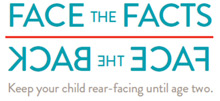Latest Recommendations Urge Parents to Keep Children in Rear-Facing Car Seats Until Age 2
 Parenting young children is all about milestones – watching and anxiously awaiting for the first step, first tooth, and first word. But when it comes to keeping little ones safe in the car, parents should not be too eager to reach the milestone of turning them around into a forward-facing car seat.
Parenting young children is all about milestones – watching and anxiously awaiting for the first step, first tooth, and first word. But when it comes to keeping little ones safe in the car, parents should not be too eager to reach the milestone of turning them around into a forward-facing car seat.
That is because children riding in rear-facing seats are much safer. In fact, children who ride rear facing are five times safer than those riding forward facing. While many parents have heard from friends or family that 1 year and 20 pounds are the requirements for turning car seats around, this is outdated and inaccurate information.
As of 2011, the official recommendation from the American Academy of Pediatrics and the National Highway Traffic Safety Administration is to keep kids in rear-facing car seats until at least age 2, or until they reach the maximum height or weight of the seat.
The reason that rear facing is safer for small children is simple. In a rear-facing car seat, the baby’s entire body is protected by the shell of the seat. These seats are designed to protect a child’s head, neck and spine and prevent the most life-threatening and debilitating injuries in a crash. The bodies of children in forward-facing seats are restrained by the harnesses, but in a crash the head is thrown forward, stressing, stretching or even breaking the spinal cord.
Why Common Objections Are Not Worth the Risk
The certified child passenger safety technicians at University Hospitals Rainbow Babies & Children’s Hospital install more than 1,000 car seats a year. Take a look at some of the most common objections they hear to keeping kids rear facing and learn why even these concerns can not compete with the simple fact that rear-facing children are five times safer.
Learn More or Make a Safety Seat Installation Appointment
For questions about car seats or to schedule an appointment to have your seat installed by a certified child passenger safety technician at UH Rainbow Babies & Children’s Hospital or UH Ahuja Medical Center, call 216-844-2277.


